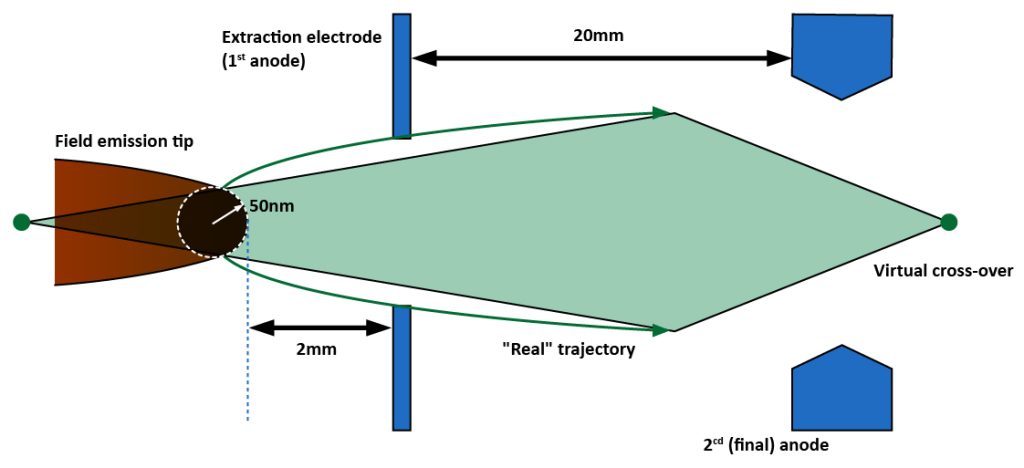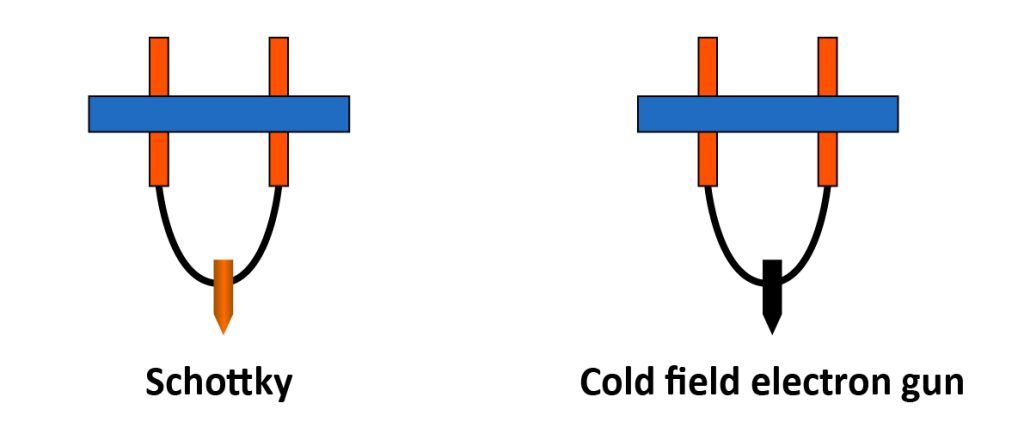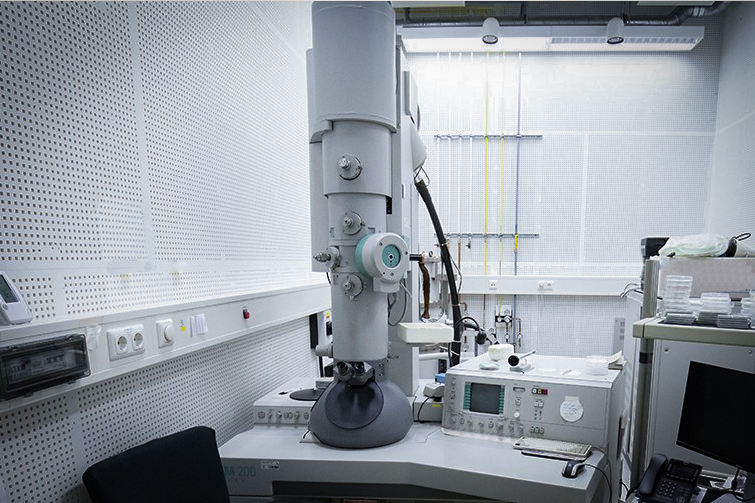A Field Emission Gun (FEG) is an electron gun in which electrons inside the metal are pumped out into a vacuum when an extraction voltage of several thousand volts is passed through a sharp metal single crystal with a tip of about 0.1 microns. These electrons are called field emission electrons, which are characterized by uniform directionality and small energy dispersion, about 0.3-0.4eV.
The part that accelerates the field emission electrons at a certain speed and sends them into the electron microscope is the field emission electron gun. It produces an electron beam about a thousand times brighter than a typical thermionic electron gun (which heats the metal, etc., to extract electrons).
Unlike thermionic emission sources, the fields in field emission sources (including cold FEGs and hot FEGs) allow a quantum mechanical tunneling process in which electrons close to the Fermi level are emitted from the tip surface without requiring an input greater than the work function that.
A field emission source consists of a pointed tungsten wire (filament emitter) exposed to a high electric field. It’s called a “field emission” gun because the electric field causes energetic electrons to be emitted from the filament emitter.
In the case of a heated FEG (Schottky emitter), the tip of the wire is coated with ZrO2 (zirconia) to improve conductivity.
The main advantages of cold FEG are small energy distribution and long life, but small total current and poor long-term current stability.

As shown, the “extraction” field is generated by the first anode, which is charged by an extraction voltage of a few kV relatives to the tip. The electrons are then accelerated into the EM (electron microscope) column using a second anode.
The combination of the two anodes works like an electrostatic lens, creating a “virtual” gun crossing.
The overall effect of this setup is a dramatic increase in the number of electrons drawn from the tip. The current density generated by the field emission source is larger than that generated by the thermionic source, and the brightness of the generated electrons is about 10 to 100 times higher than that of the thermionic single crystal LaB6 emitting filament.
The main disadvantage of field emission sources is that the high electric field generated at the tip requires an ultra-high column vacuum to maintain stable emission.
Schottky Thermal Field Emission Electron Gun
There are two main ways to improve the resolution of the scanning electron microscope: one is to solve the illumination source. Only when the incident beam current density is high enough, can the incident beam spot be further reduced. The incident beam spot is small enough and the resolution can be high;
The second is to improve the collection efficiency of imaging information and the conversion sensitivity of the detector as much as possible. The more imaging information is received, the signal-to-noise ratio and definition of the image can be further improved, and the beam spot can be further reduced by going back. Thus, the resolution of the image is higher.
A high-brightness field emission electron gun can be used as the cathode of the electron source to increase the beam current density, thereby increasing the brightness. The heating current of the Schottky thermal field emission electron gun is usually between 2.0-2.5A. The field emission electron gun with a tungsten needle tip wrapped with zirconia has a high working temperature, which is convenient for the zirconia to melt on the surface of the tungsten to form a covering layer. Emitting under the same emission electric field The current is much higher than the pure tungsten tip of cold field emission, so it has the characteristics of high brightness, good stability, small beam spot, and dispersion, and is the electron gun with the best comprehensive performance and the first choice for high resolution of components.
Advantages: No need to heat the needle tip before use, the small size of the electron source, similar brightness to the cold field; vacuum requirement is 10 times lower than the cold field.
Disadvantages: The resolution will be slightly worse than that of the cold field, and the price will be high.
Cold field emission electron gun
Using the tip of single crystal tungsten as the emission source of the cathode of the electron gun, the beam current density is higher and the resolution is better.
Advantages: the brightness is 100-1000 times higher than LaB6, the heating temperature is low, the size of the electron source is small, and the brightness is high.
Disadvantages: The needle tip needs to be heated before use, and requires a higher degree of vacuum. It is not suitable for WDS, CL, EBIC, etc. detection.

| Electron gun | Light source size | Brightness | Dispersion | Cathode temperature | Lifetime | Vacuum |
| Schottky | 15~20nm | 108 | 0.7~1 | 1800K | 1~3year | 10-7Pa |
| Cold field electron gun | 5~10nm | 108 | 0.3 | 300K(R.T.) | few year | 10-8Pa |
In electron microscopy, a field emission gun is used to generate an electron beam that is smaller in diameter, more coherent, and has a current density or brightness three times higher than conventional thermionic emitters such as tungsten or lanthanum hexaboride. Order of magnitude (6 in the laboratory) – pointed filaments. Both scanning electron microscopy and transmission electron microscopy have resulted in significantly improved signal-to-noise ratios and spatial resolution compared to thermionic devices, as well as greatly improved emitter lifetime and reliability.
